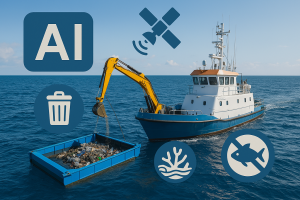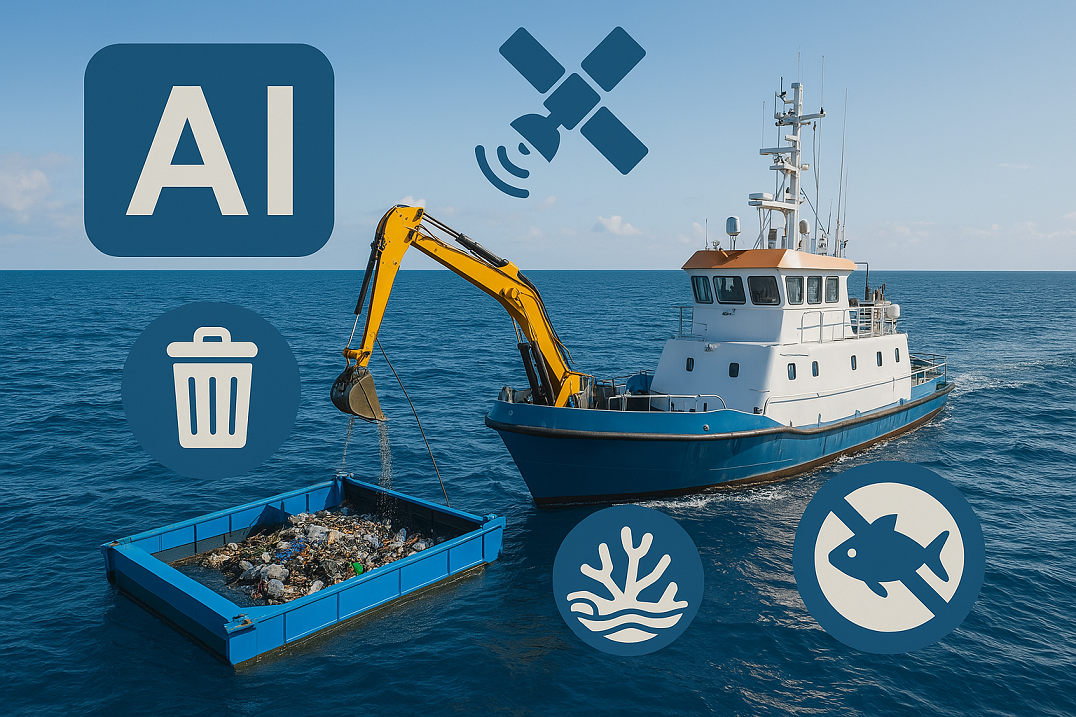
Explore how AI for ocean cleanup is transforming marine conservation. Learn how AI tracks illegal fishing, maps coral reef health, and powers drones to detect oil spills—vital for maritime students, officers, and environmental professionals.
Can artificial intelligence help save the world’s oceans?
As the maritime industry embraces sustainability, AI is emerging as a powerful ally in protecting marine ecosystems. From detecting illegal fishing to monitoring coral reefs and supporting ocean cleanup, AI in marine conservation and oceanography is reshaping how we manage, preserve, and interact with the sea.
This article explores the growing role of AI for ocean cleanup, with insights tailored for maritime students, cadets, ship officers, shipping companies, and environmental professionals. We’ll answer key questions such as:
- Can AI track illegal fishing through satellite data?
- How does machine learning monitor coral reef health?
- Can AI-powered drones detect oil spills at sea?
–
What Is AI in Marine Conservation?
Artificial Intelligence (AI) in marine conservation involves leveraging advanced digital technologies—like machine learning, computer vision, and satellite analytics—to safeguard marine ecosystems. From tracking endangered species to detecting illegal activities at sea, AI enhances our ability to monitor, understand, and respond to oceanic challenges with greater speed and precision.
Core Benefits of AI in Oceanography
AI brings transformative advantages to ocean research and conservation. It enables real-time surveillance over vast and remote marine areas, automates threat detection such as pollution or illegal fishing, and supports faster, more informed decisions. Moreover, AI reduces the need for human intervention in dangerous fieldwork, making marine science safer and more scalable. In short, the core benefits of AI in oceanography are:
-
Real-time monitoring of vast ocean areas
-
Automated detection of environmental threats
-
Enhanced decision-making for conservation policies
-
Reduced human workload in hazardous marine research
⚓ Keyword Spotlight: “AI for ocean cleanup” is now a trending topic across sectors like sustainability, blue economy, and digital maritime innovation.
–
🌊 AI for Ocean Cleanup: Smarter Solutions for Marine Pollution
Plastic pollution is choking marine ecosystems, but AI is now part of the solution. By combining satellite imagery with computer vision, AI can identify plastic clusters, model how ocean currents move debris, and guide autonomous vessels to clean up targeted areas. Initiatives like The Ocean Cleanup are using this tech to make marine cleanup smarter and more efficient. AI is now being used to:
-
Detect plastic concentrations using satellite imagery and computer vision
-
Predict ocean currents to model debris movement
-
Power autonomous vessels that collect floating waste (e.g., The Ocean Cleanup’s Interceptor)
Real-World Example:
This globally recognized initiative uses AI-powered sensors and mapping tools to pinpoint high-density plastic zones, such as the Great Pacific Garbage Patch. These insights guide interceptor vessels to optimize cleanup routes, demonstrating AI’s real-world impact in ocean restoration.
📊 Stat: According to the UN, over 11 million metric tons of plastic enter the ocean annually. AI is helping reduce that number with smarter, faster intervention.
–
🐟 Can AI Track Illegal Fishing? Global Fishing Watch’s Algorithms
Illegal, unreported, and unregulated (IUU) fishing is a massive global issue. AI tackles it by analyzing vessel tracking data (AIS) and using machine learning to spot suspicious patterns—such as turning off transponders or loitering in no-fishing zones. These insights empower authorities to intervene effectively and enforce maritime laws.
How It Works:
- Uses Automatic Identification System (AIS) data from vessels
- Applies machine learning algorithms to detect suspicious movement patterns
- Identifies “dark vessels” that turn off transponders
- Flags unusual behavior like loitering in marine protected areas
Global Fishing Watch:
Backed by Google AI, SkyTruth, and Oceana, Global Fishing Watch provides an open-access platform showing global fishing activity. Governments and researchers use its real-time alerts to track illegal behavior and support sustainable fisheries management worldwide:
- Publicly accessible maps of global fishing activity
- Real-time alerts to authorities on potential illegal fishing
- Data for environmental researchers and policymakers
🛰️ Example: In 2023, Peru used AI-powered maps from Global Fishing Watch to seize illegal squid-fishing vessels operating in its exclusive economic zone.
–
🪸 Mapping Coral Reef Health with Machine Learning
AI is becoming essential in coral reef conservation. Machine learning processes drone and satellite images to detect signs of bleaching, disease, or degradation. These models help scientists monitor reef conditions over time and direct restoration efforts where they’re needed most.
AI Applications in Coral Monitoring:
- Satellite + drone imagery processed with machine learning
- Detects changes in reef color, shape, and growth over time
- Identifies bleaching events and disease outbreaks
- Helps prioritize marine protected areas (MPAs)
Example: Allen Coral Atlas
A global coral mapping initiative using AI to analyze reef health in real time. Researchers and governments use its data for:
- Restoration projects
- Policy-making
- Marine biodiversity tracking
🧠 Bonus Fact: The Allen Coral Atlas uses deep learning models trained on over 2 million labeled satellite images.
🚁 AI-Powered Drones for Detecting Oil Spills
AI-equipped drones are revolutionizing oil spill detection. These systems use computer vision to identify oil slicks and distinguish them from similar patterns like algae blooms. Mounted on UAVs and AUVs, AI enables faster, more accurate responses to marine pollution incidents.
Capabilities:
- Computer vision models detect color changes and slick patterns on water
- Real-time AI processing distinguishes oil from algae or shadow
- Integrated with Unmanned Aerial Vehicles (UAVs) and autonomous underwater vehicles (AUVs)
Case Study: NOAA’s Drone Program
The U.S. National Oceanic and Atmospheric Administration (NOAA) deploys drones with AI to validate satellite alerts, map spill areas, and assist emergency responders. Their work has helped reduce environmental damage and cleanup costs by up to 40%:
- Track offshore oil spills
- Support emergency response efforts
- Validate satellite-based alerts with aerial verification
🛢️ Result: Early detection reduces environmental damage and cuts cleanup costs by up to 40%.
–
🔍 Latest Trends & Tools in AI Marine Tech
AI in the marine world is advancing rapidly. Smart marine robots are collecting waste and planting corals, while “Ocean Digital Twins” simulate marine ecosystems to predict environmental changes. Crowdsourced data from sailors via mobile apps is training new AI models, and open datasets like Seabed 2030 are fueling breakthroughs in ocean mapping and protection.
| Trend | Details |
|---|---|
| AI-Powered Marine Robots | Used for debris collection, coral seeding, and seabed exploration |
| Ocean Digital Twins | Simulate ocean systems to predict marine events and pollution flow |
| Crowdsourced Data + AI | Mobile apps allow sailors to upload data for training marine AI models |
| Open-Source Marine Datasets | Platforms like Seabed 2030, Global Fishing Watch, and ReefCloud |
📈 Stat: According to the World Economic Forum, AI and automation could help protect 30% of global oceans by 2030.
–
FAQs: People Also Ask
Can AI detect marine pollution?
Yes. AI analyzes satellite images, drone footage, and ocean sensors to identify plastics, oil spills, or sewage leaks.
How does AI help marine biologists?
AI helps classify species, model habitats, and track changes in ecosystems—saving time and improving accuracy.
Is AI used in ocean mapping?
Absolutely. AI models assist with bathymetric surveys, coral mapping, and seabed classification using sonar and satellite data.
Are there AI robots cleaning the ocean?
Yes. Autonomous vessels like The Ocean Cleanup Interceptor and robotic arms in ports are actively collecting surface plastic using AI navigation.
–
Conclusion
The use of AI for ocean cleanup, conservation, and marine monitoring is opening new frontiers for both environmental protection and maritime innovation. Whether it’s through detecting illegal fishing, mapping coral reefs, or preventing oil disasters, AI is enabling a cleaner, safer, and more sustainable ocean future.
🌊 Call to Action: Future maritime professionals must understand how AI can support not only shipping and logistics—but also environmental stewardship. Learn, apply, and advocate for smarter, AI-powered ocean solutions.
References & Further Reading
- Global Fishing Watch
- The Ocean Cleanup Project
- Allen Coral Atlas
- NOAA Marine Technology
- World Economic Forum – Ocean AI Insights
By: Reza Karimpour, PhD.

